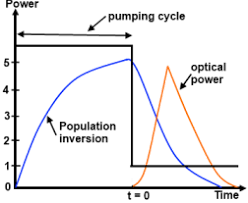
Q-switching is the most effective method for producing high energy pulsed lasers. While there are many different varieties of a q-switch, they all follow the same basic operating principle. Q-switches temporarily increase the cavity losses so that the gain threshold is artificially high preventing the laser from emitting light. This process allows the population inversion inside of the gain medium to grow until it becomes fully saturated. At this point, the q-switch is “opened” causing the cavity losses to plummet, dropping the gain threshold, and allowing all of the stored energy in the gain medium to be emitted in one rapid pulse. This process, which is illustrated in the figure below causes the emission of extremely short pulses of light with extremely high peak powers.

While there are a wide variety of q-switch technologies, notably including acousto-optic and electro-optic modulators, the technique as a whole can be broken down into two primary categories of q-switches, passive and active. Active q-switches rely on the ability of “flip a switch” and rapidly adjust the lasers cavity loss. A perfect example of this is an acousto-optic modulator, which, when activated creates a grating which deflects many spontaneously emitted photons out of the laser cavity, but once the modulator is turned off it allows the spontaneous photons to pass through and initiate stimulated emission. Passive q-switches, on the other hand, take advantage of a process known as saturable absorption. Saturable absorption derives from the fact that there is a limit to the amount of light that a material can physically absorb at a given wavelength before the energy level become saturated and the material becomes temporarily transparent. As a result, if a saturable absorbing material is placed inside of the laser cavity, it will absorb all of the spontaneously emitted photons until it reaches saturation where it will then allow the photons to pass through and initiate stimulated emission.
Both of these q-switching techniques produce short pulses and high peak powers, but they each have their pros and cons. For example, active q-switching allows the user far more control over when the pulse will be emitted and therefore how long population inversion will be allowed to build up. But, on the other hand many common active q-switches such as Pockels cells (which utilize the electro-optic effect) often require the driver to swing several kilovolts each time the switch is triggered. By contrast saturable absorbers require no drivers at all, meaning that not only are they compact, but they are also far less expensive. As a result, when you are deciding between an active versus passive q-switched laser there are four key things that you must keep in mind.
- Cost – In general, actively q-switched lasers will always be more expensive than passively q-switched devices. This point should be self-explanatory, but for the sake of completeness, it is essential to point out that saturable absorbers not only have no drive electronics, but they are also far less complicated to construct. As a result, if cost is the primary motivator, then you should always try to find a passively q-switched solution whenever possible.
- Size – An added benefit of saturable absorbers being such simple devices is that they can be constructed in virtually any size imaginable. For example, they are commonly used in microchip lasers where a passive q-switch is monolithically bonded to the laser crystal. In many cases, the saturable absorber can also double as the output coupler resulting in a total optical cavity length on the order of only 1 millimeter. By contrast most electro-optic and acousto-optic q-switches can be up to 10 centimeters in length with clear apertures between 1 and 2.5 centimeters in diameter.
- Triggering – One of the significant disadvantages of passive q-switching is that you have no control over when the laser actually pulses. The laser’s pulse repetition rate will be solely dependent on the when the absorber saturates. This is very much akin to a free-running system which not only cannot be controlled but also can experience pulse to pulse variability or jitter. An actively q-switched laser, on the other hand, provides the ability to trigger the pulse at a specific time and with a particular pulse repetition rate. This makes it far easier when synchronizing the laser to other instrumentation, such as a kinematic arm for laser machining or a spectrometer for laser-induced breakdown spectroscopy (LIBS). It should be noted though that most passively q-switched lasers do contain an internal photodiode that can be used to synchronize to an external device, but this not nearly as flexible as the ability to trigger in.
- Pulse Energy – While some passive q-switches are capable of producing rather large, mJ level, laser pulses, in general active q-switching tends to lead to far larger pulse energies. This is because the q-switch can be actively controlled to allow for the maximum shutter time needed for full population inversion. As a result, the q-switch can be timed to open with the same period as the decay lifetime of the gain medium’s metastable state resulting in the maximum possible pulse energy. By contrast with a passive q-switch once the absorber has saturated it will release all of the stored energy regardless of whether or not maximum population inversion has been achieved.
In summary, when choosing between nanosecond and picosecond pulsed actively q-switched and passively q-switched lasers, the key is to understand the tradeoffs between cost/size and triggering/energy and decide which is best for your particular application.
Talk to one of our knowledgeable Product Managers today by emailing us at info@rpmclasers.com or Contact Us with the button below!
Have questions?

 SHIPS TODAY
SHIPS TODAY 